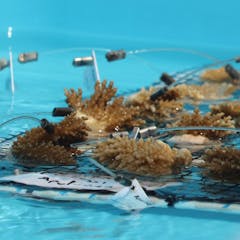
Articles on Coral bleaching
Displaying 1 - 20 of 118 articles

Bleached coral draws our attention, but marine heat does damage to many unseen parts of these ecosystems.

The Great Barrier Reef is facing its worst summer of sustained heat stress since the mass bleaching event of 1998, but now with less time to recover amid repeated brutal conditions.

The best strategy to protecting Earth’s coral reefs is to dramatically cut greenhouse gas emissions. But in the meantime, we must urgently make corals more resilient.

Tourists flock to see coral reefs in Gili Matra, near Bali, which are at growing risk from warming seas. Locals are working to restore coral, while coming up with new income sources – like fish floss.

Severe bleaching is forecast to hit 12 Indonesian marine protected areas every year by 2030 – then spread to other areas. Here’s what locals, experts and the government say we need to do to save them.

Australian is experimenting with marine cloud brightening to cool and shade the Great Barrier Reef. Here’s how it works.

Understanding how both cloud cover and temperature work to promote coral bleaching provides valuable insight into how reefs will change over various climate scenarios.

Coral has been incorporated into traditions, art and even religion in communities around the world.

This may buy us time, but many reefs are still doomed without serious action on climate change.

We used to focus just on protection of vital ecosystems like the reef. But as climate change and other threats accelerate, we need to actively help nature get ready for the heat.

Ocean temperatures have hit record highs off the Florida Keys. Scientists and volunteer divers are racing to save these valuable creatures.

In recent years, the Barrier Reef has had a reprieve – and coral has regrown strongly. But now the reprieve looks to be over and the heat is back on

Incrementalism and politics as usual cannot save the Barrier Reef from the largest threat it faces – the heat ramping up from climate change

This knowledge is particularly important if we want to help reefs recover devastating events such as mass bleaching and cyclones.

The scale of climate threat is beyond the tools we have to manage the Great Barrier Reef. New measures and sustained effort are needed.

Environment ministers from both sides are determined not to see the Barrier Reef listed as in danger. The question is – why?

Efforts to save the reef aren’t tackling the main cause: climate change. What we need from our next federal government is strong leadership to avert the climate crisis.

Researchers have long suspected that an ingredient in sunscreen called oxybenzone was harming corals, but no one knew how. A new study shows how corals turn oxybenzone into a sunlight-activated toxin.

Coral reefs that suffer widespread bleaching can still recover if conditions improve, but it’s estimated to take up to 12 years. And that’s if no more bleaching events occur.

Laboratory studies suggest sunscreen chemicals are dangerous to coral reefs. But in real world conditions, that’s not true. Bleaching must have another cause.
